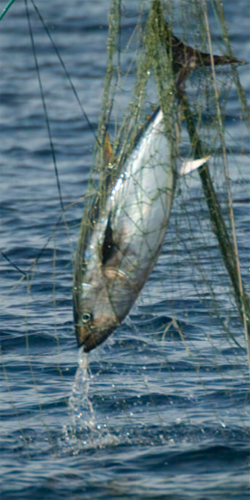Mediterranean Driftnets: A History of (In)Action
 "Driftnet": [noun] any gill net held on the sea surface or at a certain distance below it by floating devices, drifting with the current, either independently or with the boat to which it may be attached. It may be equipped with devices aiming to stabilise the net or to limit its drift. — European Union Council Regulation (EC) No 809/2007
"Driftnet": [noun] any gill net held on the sea surface or at a certain distance below it by floating devices, drifting with the current, either independently or with the boat to which it may be attached. It may be equipped with devices aiming to stabilise the net or to limit its drift. — European Union Council Regulation (EC) No 809/2007
Background
Driftnets have been banned within national waters by many countries on the high seas by international bodies, including the United Nations, in large part because of the sheer waste associated with this fishing method. In addition to the species they target, driftnets kill large numbers of animals as bycatch—marine species not intended for capture—including whales, sea turtles, dolphins, and sharks.
However, an active—and often illegal—driftnet fleet continues to operate from Italy. Vessels with driftnets targeting Atlantic bluefin tuna and swordfish, even though the International Commission for the Conservation of Atlantic Tunas (ICCAT), the body responsible for management of these vulnerable species, has banned the use of driftnets to capture them. The European Union is a member of ICCAT, so Itay is required to comply with all ICCAT decisions. Recent investigations in Italy have revealed that authorities are taking no action to enforce the driftnet ban. In July 2011, a widespread illegal trafficking ring was uncovered, along with evidence that bluefin catch documents were regularly being falsified or withheld, allowing tuna caught by driftnets to enter the market illegally.
Action Needed
The Pew Environment Group urges the EU and ICCAT to take firm action to address Italy's continuous flouting of the driftnet ban. As an immediate first step, any Italian operators known to have engaged in prohibited driftnet activities should be placed on ICCAT's vessel blacklist. This would prohibit them from landing bluefin tuna or swordfish and would discourage importers and other sectors from purchasing fish from these vessels. ICCAT countries also should implement an electronic catch documentation system to address the fraud, misinformation, and delays associated with the current paper-based tracking system.











